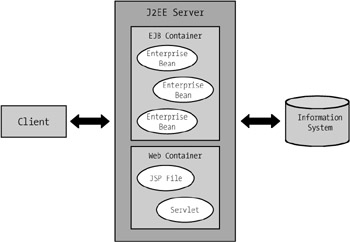The Server
The server is the fundamental component of the EJB architecture. Here we are deliberately not speaking of an EJB server. Actually, it should be called a J2EE server. Sun Microsystems' strategy in relationship to enterprise applications in the framework of the J2EE platform involves Enterprise JavaBeans to a considerably greater extent in the full portfolio of Java-based programming interfaces and products than was the case in version 1.0 of the Enterprise JavaBeans specification.
The specification of Enterprise JavaBeans in version 2.1 does not define any sort of requirement on the server (just as in versions 1.0 and 1.1). The reason for this is presumably their stronger integration into the Java 2 platform, Enterprise Edition (see Figure 3-2).

Figure 3-2: EJB in the context of Java2, Enterprise Edition.
A J2EE-conforming server is a run-time environment for various containers (of which one or more can be EJB containers). Each container, in turn, makes a run-time environment available for a particular type of component. Creators of Java application servers tend more and more to support the J2EE platform. There is scarcely a producer who offers a pure EJB server. Many suppliers of databases, transaction monitors, or CORBA ORBs have meanwhile begun to support Enterprise JavaBeans.
In the environment of the J2EE platform (and thus indirectly in the EJB architecture) the server component has the responsibility of providing basic functionality. This, includes, for example:
-
Thread and process management (so that several containers can offer their services to the server in parallel);
-
Support of clustering and load sharing (that is, the ability to run several servers cooperatively and to distribute client requests according to the load on each server to obtain the best-possible response times);
-
Security against breakdown (fail-safe);
-
A naming and directory service (for locating components);
-
Access to and pooling of operating system resources (for example, network sockets for the operation of a web container).
The interface between the server and containers is highly dependent on the producer. Neither the specification of Enterprise JavaBeans nor that of the Java 2 platform, Enterprise Edition, defines the protocol for this. The specification of Enterprise JavaBeans in version 2.1 assumes that the producer of the server and that of the container are one and the same.
EAN: 2147483647
Pages: 103
- Integration Strategies and Tactics for Information Technology Governance
- Linking the IT Balanced Scorecard to the Business Objectives at a Major Canadian Financial Group
- Measuring and Managing E-Business Initiatives Through the Balanced Scorecard
- Governance in IT Outsourcing Partnerships
- Governance Structures for IT in the Health Care Industry